Inside and outside the museum, symbolic forms of understanding art
Collective TLC – Trafico Libre de Conocimientos – Estrella Luna MuñozTLC – Tráfico Libre de Conocimientos (Free Traffic of Knowledge) is a collective organized by eight Mexican artists since 2011. Born from artistic practices that understand art as a mediator and generator of knowledge, our research explores different ways of connecting and various ways to inhabit; with this we seek to generate critical thinking, bridges of interaction and to reactivate spaces of collective learning. The projects respond to the contexts in which they occur, from public spaces to cultural centers, galleries, museums and schools, both rural and urban.
Two years ago, we started getting invited to work for the educational departments of some of Mexico City museums such as the Museo Tamayo and the Museo Jumex. Both sought for ways of mediation between the public and the exhibition. Mediations beyond the classic summer course based on replicating the techniques of an artist or the conference format. They wondered what was the role of education in a museum of contemporary art and who could build bridges for working together. We discovered that both areas were interdisciplinary with artists, art historians and teachers, which facilitated the collaborative work with the team thanks to their openness for experimentation.
We were invited to work in the setting of a main show in each museum. From the start we never intended to illustrate what was shown in the galleries, but to continue with a research for future action. We adopted the proposal made by Luis Camnitzer to identify the artist's questions, so that others can solve them with their own media and generate different pieces from the ones exposed. So we checked what were the questions of the artists that we'd work with in each exhibition, and that way we collectively re-contextualized it with our own questions and those from the public.
TLC + TAMAYO
One of the first projects that we made in a museum space was at the Museo Tamayo. Each year, the educational department of the museum plans a summer workshop related to the exhibition taking place. In 2015, we were invited to design one of these courses, since they wanted to show children that the artists can also work collectively and not just individually. Back then, the main show was Relato de una Negociación by Francis Alÿs. After reviewing the main ideas of the Belgian artist, we decided to work with the concept of «bridge» and make it more complex with questions arising from our work. Then we designed a series of exercises that experienced the idea of collectivity as a principle generator of symbolic, affective and language bridges.
The workshop was entitled Todos juegan, todos ganan (Everybody Plays, Everybody Wins) and the axis that went through all the activities was the Game, because we considered it as a way of thinking which allows for meaningful learning. So, activities were based on ludic strategies that sought to expand the boundaries of communication between individuals.
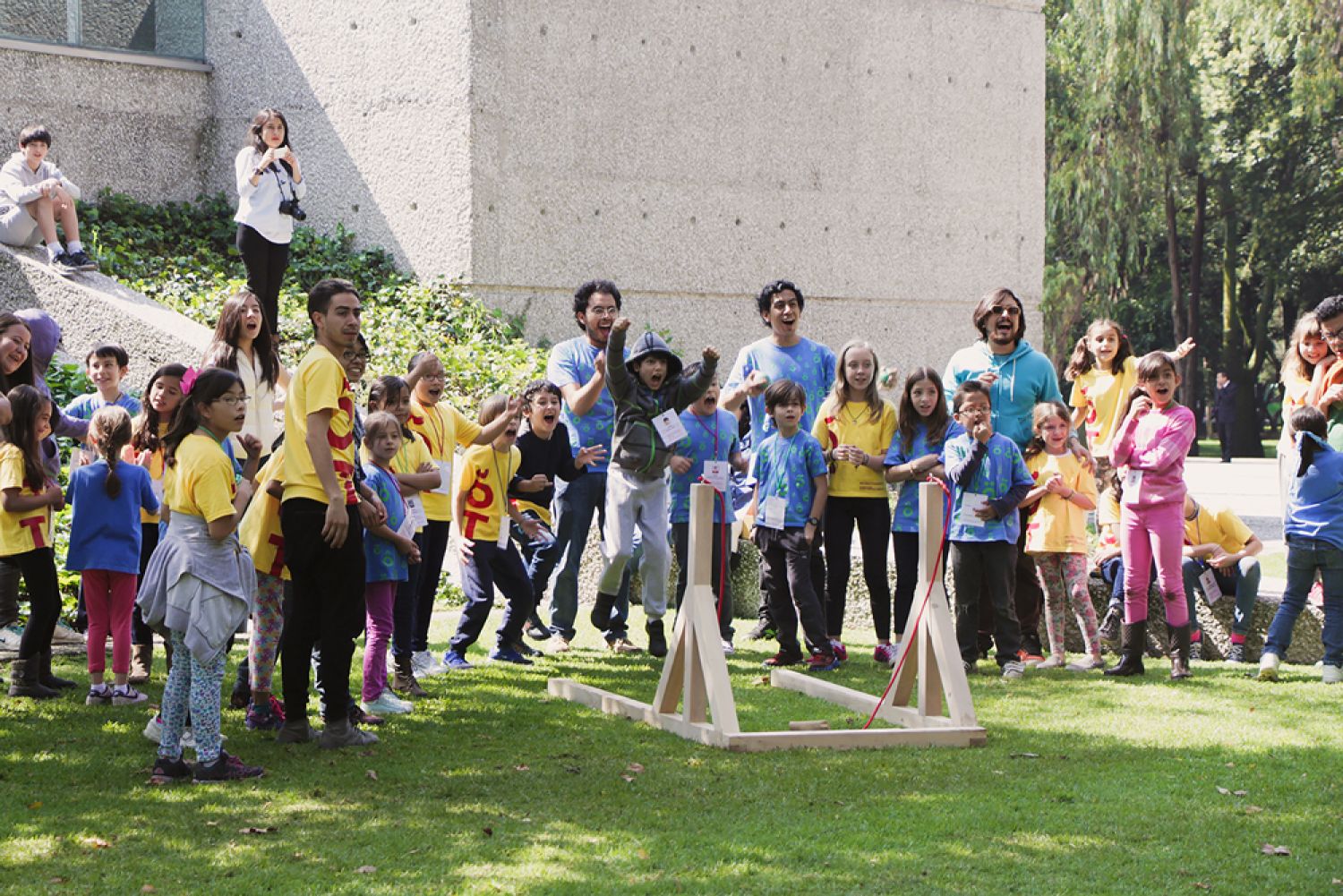
In designing activities, we defined four areas of everyday life that we thought were basic: the body, the home, the school and the city. These areas triggered questions ranging from individual to social: how do we interact with our body, with the space where we live, the people we see every day, the people we play with, and with those we don't even imagine they exist? How do we learn? Does everybody learn from everybody? Each exercise is linked with one or more of these questions and gradually connected from particular to general. So we got to the point in which the last exercise consisted in the construction of a game area for 40 children. Here we proceeded to the construction of a network which required the participation of all to be achieved, generating a collective and dynamic work.
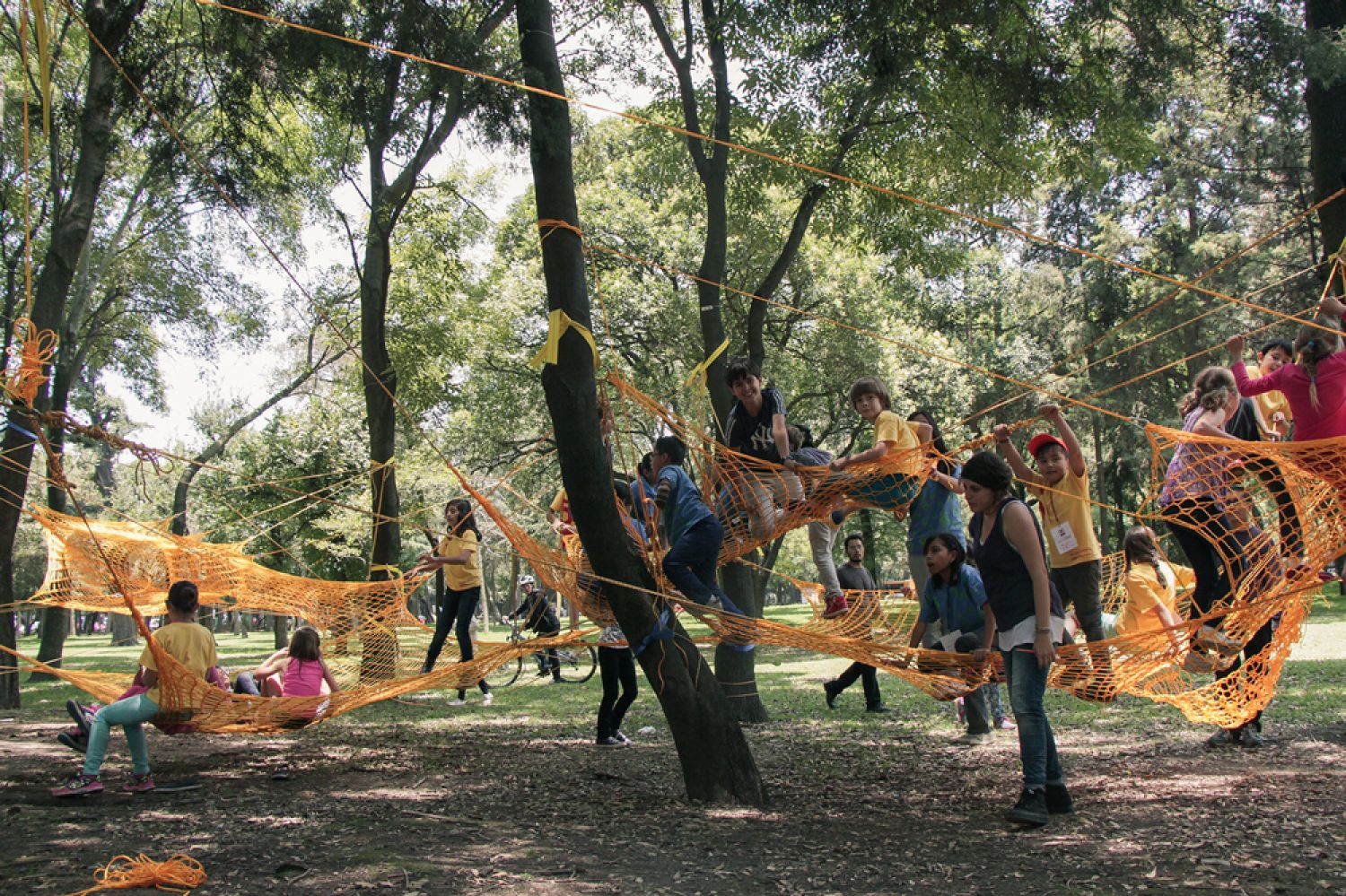
TLC + JUMEX
In 2016, the educational department of the Museo Jumex invited us to design a mediation with the public around the exhibition How to Work Better by Fischli & Weiss. Once more, we worked with said department to carry out a project we entitled Tiempo Fuera (Time Out). First we choose some of the questions made by the Swiss artists in their production which resounded with our interests. The relations between time, game and leisure led the proposal.
Tiempo Fuera was divided into two parts. The first was entitled Juegos mínimos, which we designed to exercise the art of wasting time and facilitate the immediate body interaction. We played in different parts of the museum where people tend to wait, whether to enter the room or the museum or to take the best picture. Certain conditions were set: to use the minimum amount of objects and not to chase people to invite them to join in the games, but let them come by their own curiosity and ask us if they could play. We made tournaments of stare-downs, thumb wars, red hands, hopscotch, and other traditional Mexican games. This created a strange view in a museum space associated to seriousness or silence and generated conversations with people we had never met, memories of games we had forgotten, and laughter and delays in the itineraries of visitors absorbed in the game.
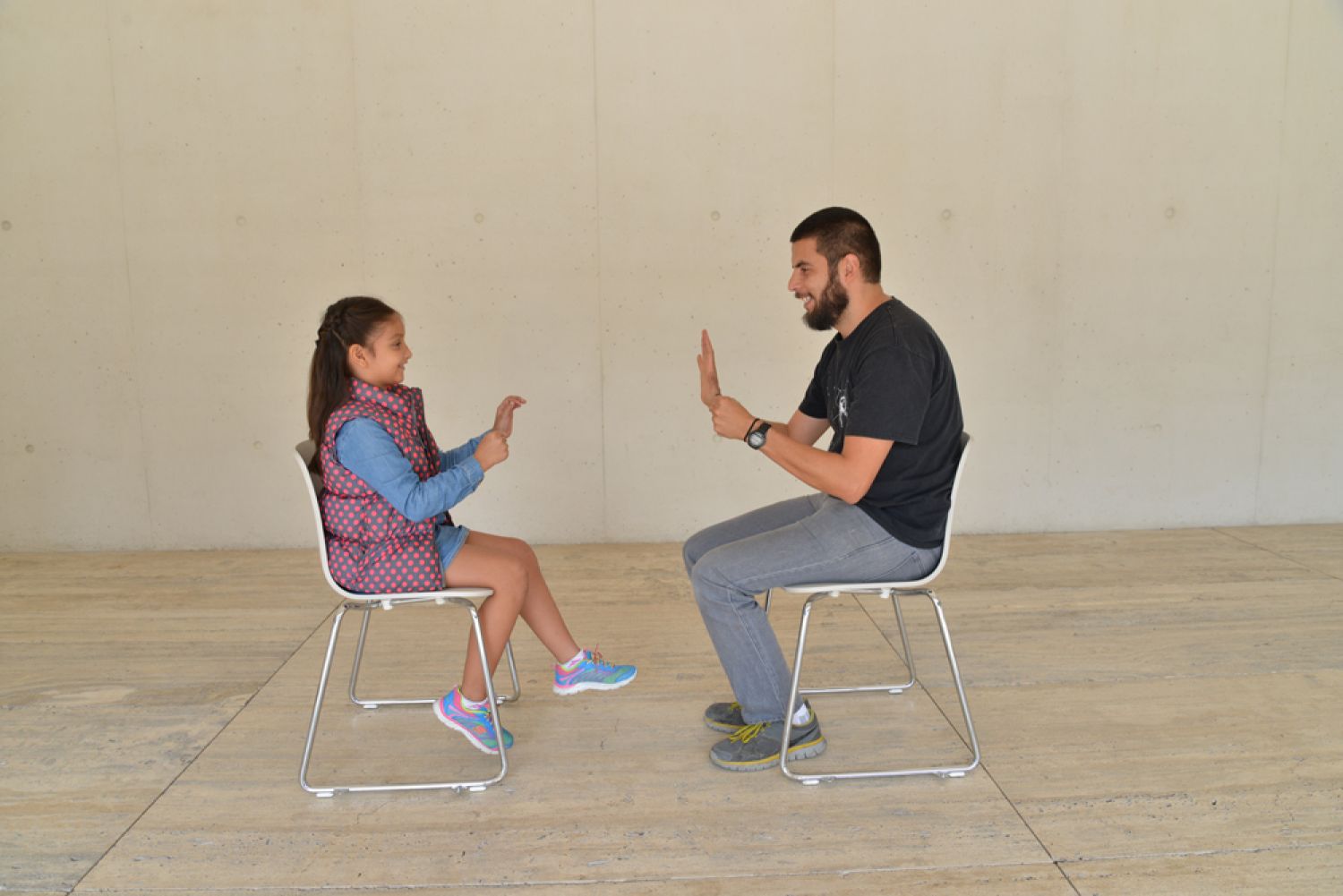
The second part, titled Tramitología, was based on the relationship between work and leisure. Here we designed a complex way to make something simple: entering the museum. With this idea we intervened the square of the Museo Jumex with a maze using rope barriers. We designed four configurations of the labyrinth and changed it every weekend to be different every day. In some cases, the form of the mazes had to be altered by the same players to solve them.
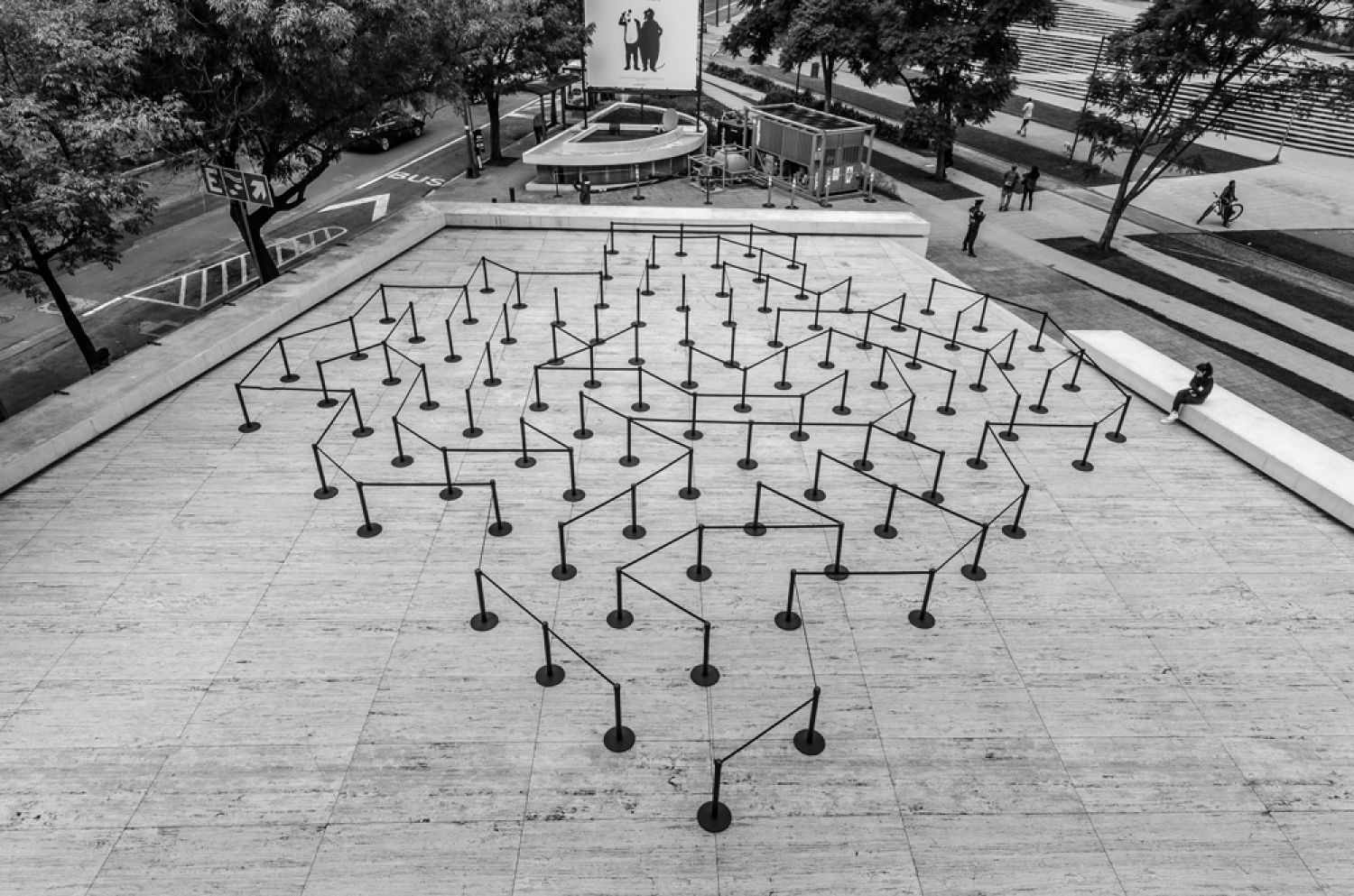
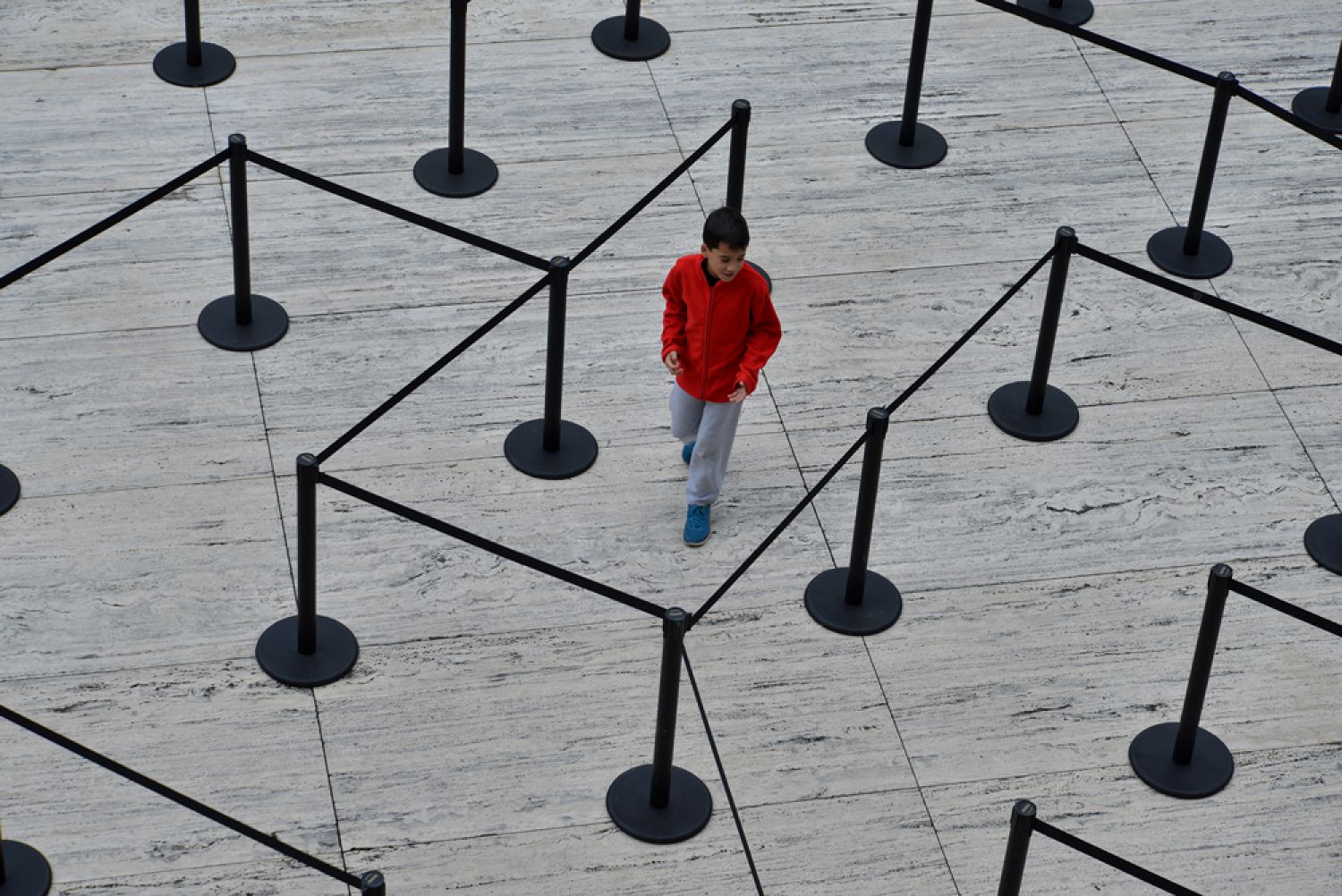
Action Points
«To collaborate in a work seems much more fruitful than the usual formula of devoting to our own work, whereas if the work is integrated between connections and establishes others in turn, it gives us a stronger sense of experience.» (Schmid, W., 2010, p. 46)
We start from the idea of collectivity as a principle generator of symbolic, affective and language bridges always within the social, political, historical and urban contexts of our environment. We propose to understand the game as a way of thinking that allows for meaningful learning. As Huizinga mentions, the game intervenes in everyday life; it is a way in which we represent society, creating or establishing points of human interaction as part of a process of constant communication.
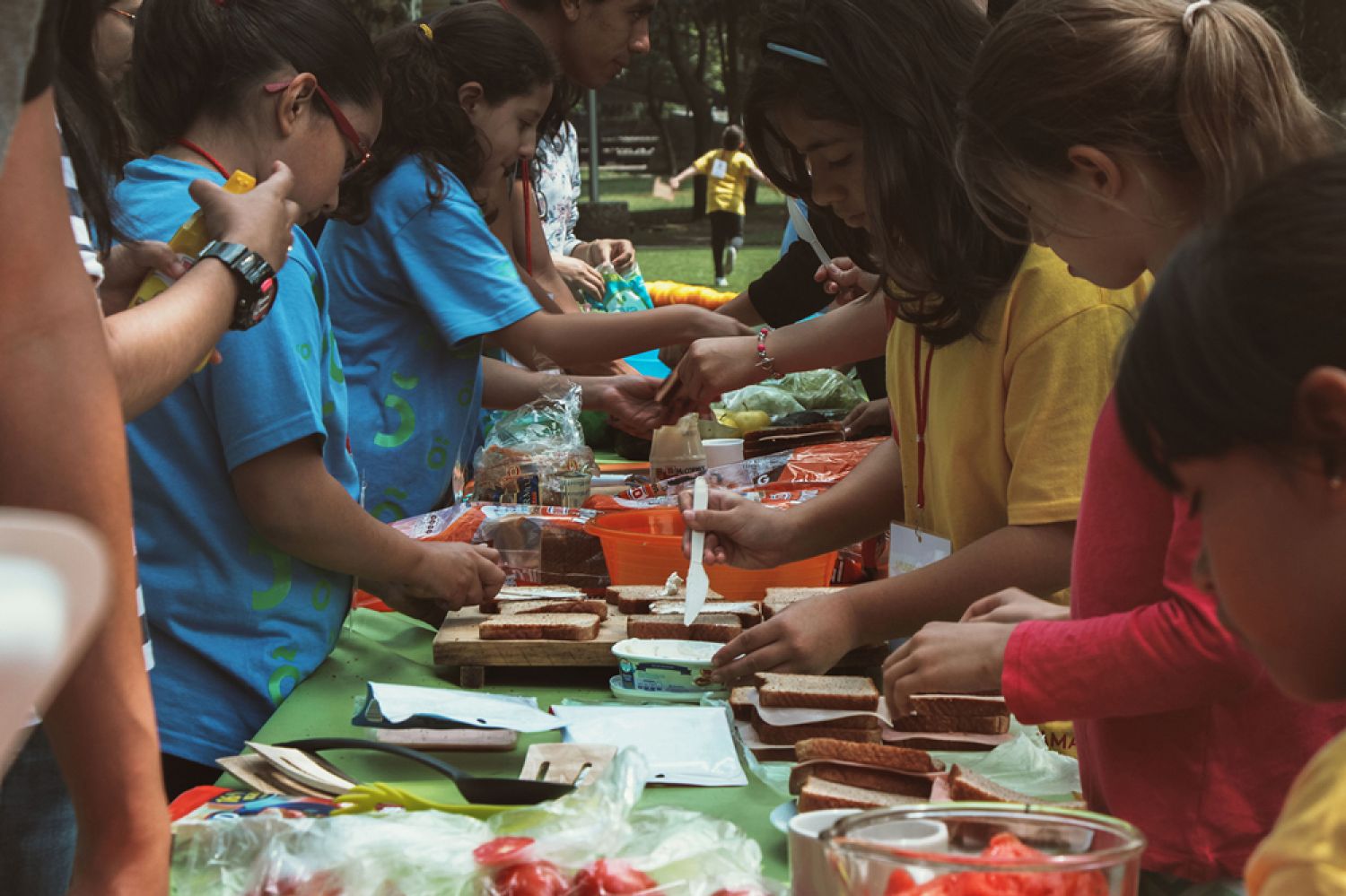
Sensations, the mind and the body, are inevitably involved, depending on the action, and by means of impulses the direction of social processes that form the final memory of our history are defined. Games produce meaning, they make up models of people's time, they are channels where the flow of information and experience results from what the activity offers: a series of micro-interactivities in different levels of the people's knowledge. The activities are based on ludic strategies which seek to expand the borders of communication between the public and the artistic pieces of the museum as well as to understand part of the artistic process as a form of experimentation in the exhibitions.
«Historical circumstances explain our nature to the extent that our nature also explains them» (Paz, 2010).
The game as a tool for creation and experimentation is a source of new symbolic ways of understanding the art and the museum in a collective manner. From the interconnected experiences of the participants, fragments of «places of memory» are created, either with the body, with the dwelling or the city, as a root of related and intertwined places borne from art.
«The games formulate and actually formalize the organizing rules of plays and also constitute a memory» (Caillois, 1986, p. 331).
We start from a methodology that seeks to instill in children and teenagers a critical and observant thinking on contemporary art, together with the current social problems and contexts. To create with them new forms of interaction and interlacing different aspects of everyday life, with actions conducted in the workshops inside and outside the museum.
In the processes of the work performed, the following points are present:
– Creativity
– The collective learning
– Critical thinking
– Art and culture as means of creation, experimentation and action
– Interdisciplinarity
– The ability to create multiple solutions
– Teamwork
– The game as means of learning
In our work with both museums the goal was to make exercises to understand contemporary artistic practices in a more active way. The objective was not to be mere spectators but to activate the experience in a museum with an activity generated from the questions and problems of current artistic proposals as mentioned above, using the Participatory Action Research (PAR) (Kemmis, S., & McTaggart, R., 2007) that is based on the participation and investigation with the members of a community – in this case the visitors and the members of the museum and us. We sought to create a construction and integration of knowledge and acts of exchange between all participants, resulting in a collaborative process, from construction to the execution of activities with the public.
The process was built based on cycles of work ranging from planning, observation, reflection and replanning which were focused on:
– Collaborative work with the museum's education team
– The interdisciplinarity used by the education team
– The actions not being illustrative of the artistic works
– The identification of the questions of the artists or artistic pieces
– The recontextualization to the environment of action
– The constant research
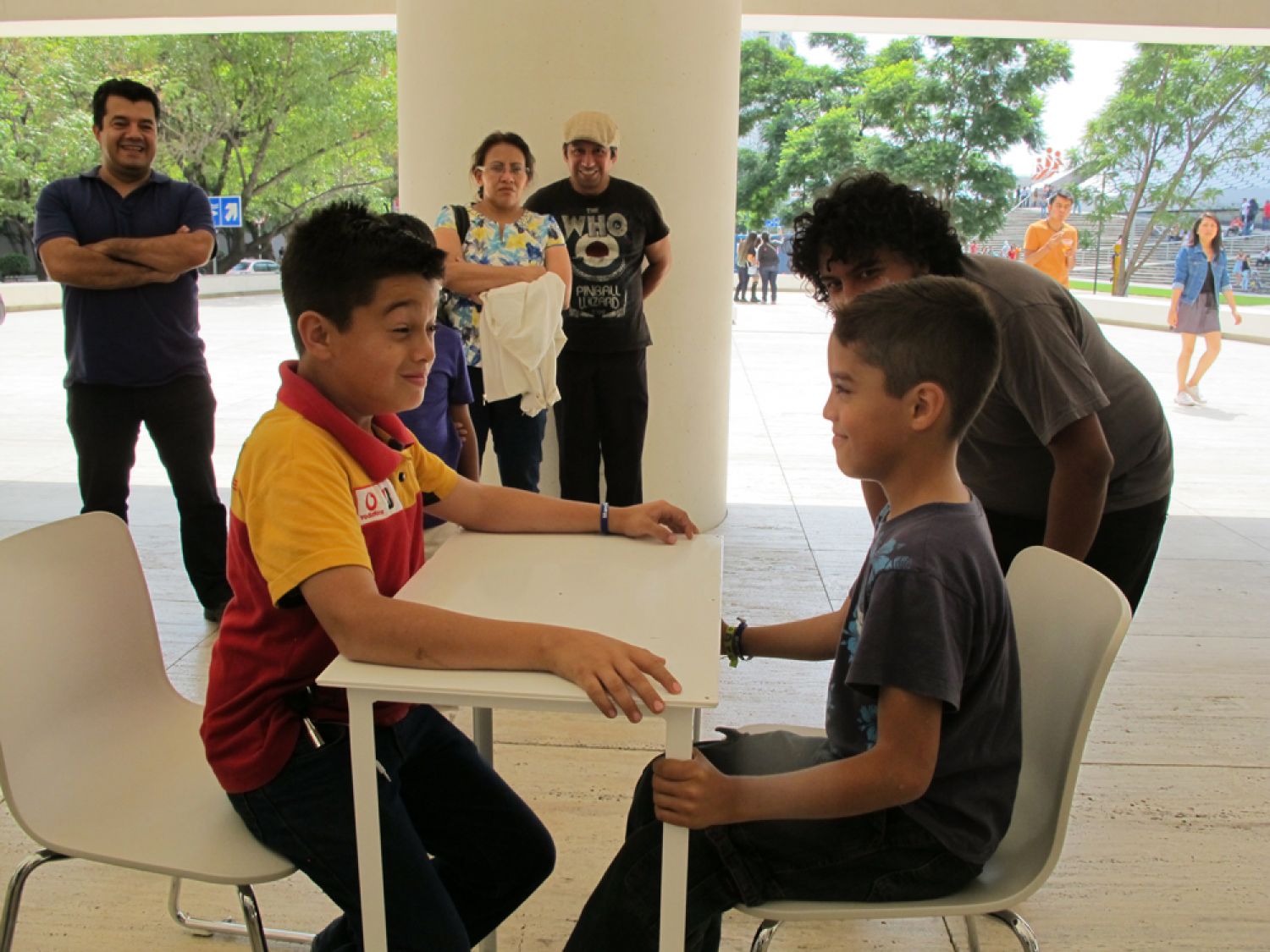
Generating other learning opportunities
In terms of strengthening skills, Stéphen Vincent-Lancrin, education expert at the Organization for Economic Co-operation and Development (OECD), mentions the five skills that should be strengthened in the upper education programs to promote innovation: creativity and the learning capacity, critical thinking and the capacity to seize opportunities and communication.
The development of these skills are the key to the twenty-first century, with the realization of actions from art, education and culture in museums and non-school environments, preparing generations for many of the current changes in society and motivating them to be critical and constructive citizens.
The subject of community and teamwork is of great importance within the dynamics to raise awareness in the public to their identity as creators and participants in their environment. The same human development can be explained in terms of social interaction, so community and teamwork are key to learning.
This social and cultural learning shapes the path of any person towards their individual and, later, collective development, key in the human education. The making and building in the museum by the viewer and visitor generate these deeper and more meaningful relationships. The experience becomes part of a relationship with the environment, inside and outside the museum, in which ideas are generated, and it allows for creativity, analysis and understanding, where visitors can pose multiple proposals, based on the exchange of experiences.
«The current art is an inexhaustible source of knowledge on all levels: psychological, emotional, cultural, experiential (...) etc»
(Amavi, 2000, p. 200).
Actions are made with the artistic pieces, their observation and its contextualization in our collective environment. So they're an integral part in a physical way interaction with the city. We're with the museum, and the museum is with us.
The Russian psychologist Lev Vygotsky considered the process of psychological self-construction, reconstruction and transformation essentially based on the social interactions from cultural mediation. He affirmed the importance of cultural development that generates social interactions, collective and individual identity, the instruments of mediation that are created and provided by the same language, exchange of information, and especially the experience by the individual with their socio-cultural environment.
Our actions are built collectively generating a collective exchange of experiences. The critical pedagogy proposed since 1970 by Paulo Freire (Freire, 2009) says that studying is not an act of consuming ideas, but of creating and recreating them. This is precisely what should be energized in the art, education and culture inside and outside museums, in order to create mechanisms of education with which, based on experience, one questions the current state of society, encouraging constructive actions.
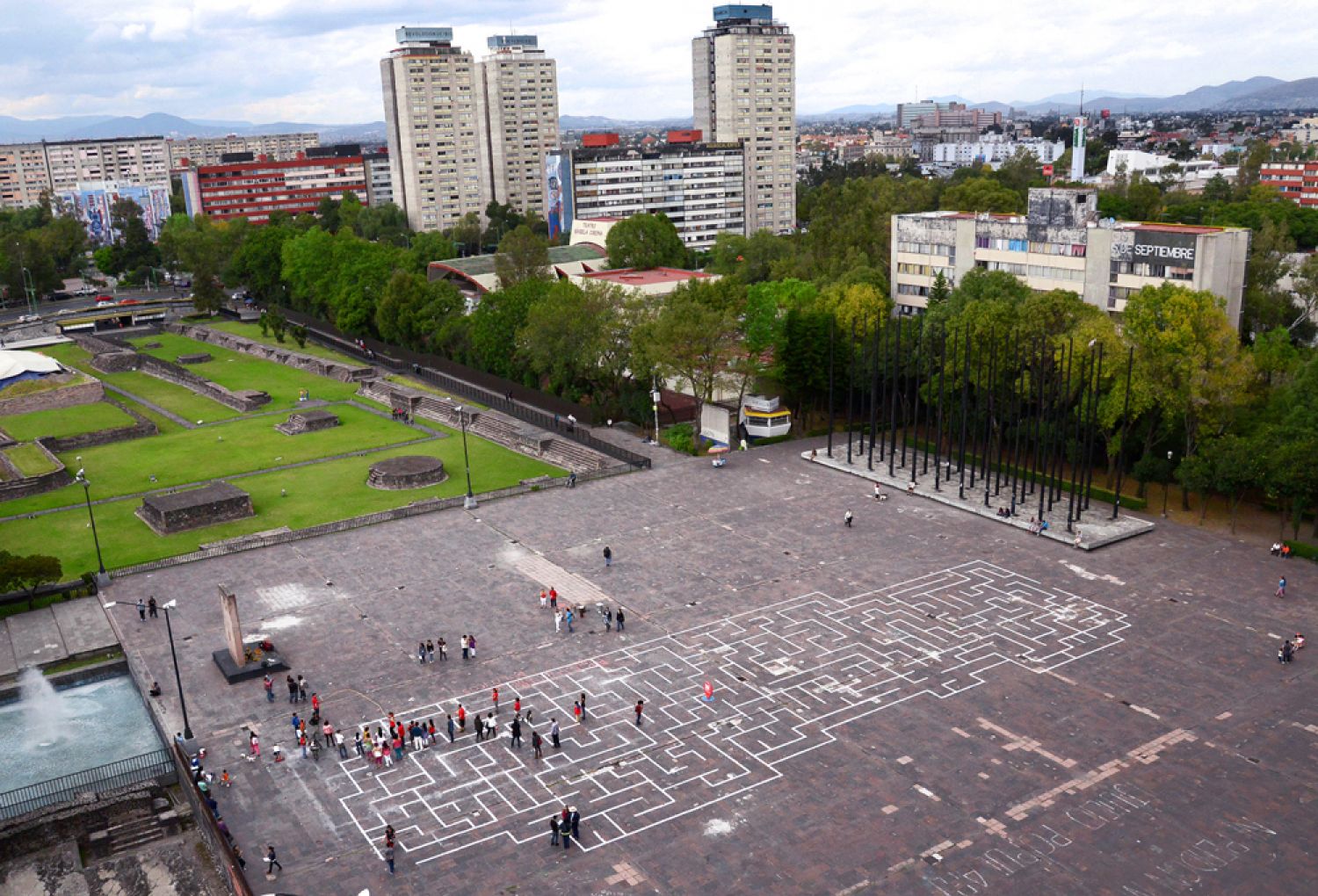
«What is needed is no longer an educated citizen, but a citizen who thinks, and modern society is demanding educators to provide children with techniques of thinking» (Tomás, A., 1991, p. 43).
So, performing this contextualization and active participation collectively is necessary to create a critical citizen. Therefore the importance of creating forms of generating relations between persons, giving way to possible emotions, is to build the experience depending on the various issues in relation to the context, to the social structures and the spaces we inhabit.
From these experiences at museums' educational department, some questions come to mind:
– Is it possible for education departments to have or generate a long-term intervention, independent of curatorship?
– Is it possible that education departments contemplate generating art works?
– How the research in the education department can transcend the curatorial agenda?
What are the ways to build a dialogue in which our interaction is mediated in the complexity of something that brings us a little together, and that somehow speaks of our context? The method of work in exhibitions or the little interaction that visitors engage with the generality in which the work of an artist is presented, makes us rethink whether this is the best approach, or rather, how can we as active viewers generate a more inclusive level over experiences of the artist reflected in the public.
The questions that we believe are relevant relate to the method of work and the interaction with the museum's visitors, somehow looking to create in a different and collective way new experiences based on activities between art and education with the museum.
Bibliography
AA.VV. (2001). Comunicaciones del congreso: Los Valores del Arte en la Enseñanza. Spain: Ed. Repro Express.
AMAVI. (2000). El aprendizaje y la enseñanza del arte. Madrid: Editorial AMAVI.
CAILLOIS, R. (1986). Los juegos y los hombres, la máscara y el vértigo. Mexico City: Ed. Fondo de Cultura Económica.
CAMNITZER, L. (2014). Guía para maestros. New York: The Solomon R. Guggenheim Foundation.
FREIRE, P. (2009). La educación como práctica de la libertad. Madrid: Siglo XXI.
GALLEGOS, X. (2013). Tiempo libre. Libro MM4. Mexico City: UNAM, Fundación/ Colección JUMEX.
HUIZINGA, J. (2008). Homo ludens. Mexico City: Ed. Fondo de Cultura Económica.
KEMMIS, S., & MCTAGGART, R. (2007). «Participatory Action Research» in DENZIN & LINCOLN (ed.), Strategies of Qualitative Inquiry California: Sage, pp. 271-330.
LUNA, E. (2016). «O livro identitário do nosso espaço». Revista Imaginar. APECV. Portugal.
PAZ, O. (2010). El laberinto de la soledad. Mexico City: Ed. Fondo de Cultura Económico.
TOMÁS, A. (1991). «Acción comunicativa y proceso educativo: Habermas, J., & Lipman, M.» Ensayos: Revista de la Facultad de Albacete.
UNESCO Office in Santiago. Regional Bureau of Education for Latin America and the Caribbean. (2013). Boletín LLECE: Habilidades para la innovación: conocimiento con una postura definida. Stéphan Vincent–Lancrin investigador principal de la OCDE. Recovered from http://www.unesco.org/new/es/santiago/press-room/single-new/news/newsletter_llece_skills_for_innovation_knowledge_with_atti/ Accessed: March 10, 2017.
VIGOTSKI, L. (2003). La imaginación y el arte en la infancia. Barcelona: Akal.
SCHMID, W. (2010). La felicidad. Todo lo que debe saber al respecto y por qué no es lo más importante en la vida. Spain: PRE-TEXTOS.



